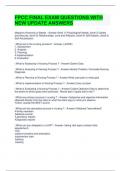FPCC FINAL EXAM QUESTIONS WITH
NEW UPDATE ANSWERS
Maslow's Hierarchy of Needs - Answer-(level 1) Physiological Needs, (level 2) Safety
and Security, (level 3) Relationships, Love and Affection, (level 4) Self Esteem, (level 5)
Self Actualization
/.What are to the nursing process? - Answer-( AAPIE)
1. Assessment
2. Analysis
3. Planning
4.Implementation
5. Evaluation
/.What is Assessing in Nursing Process ? - Answer-Gather Data
/.What is Analyzing in Nursing Process ? - Answer-Identify Problem, Formulate Nursing
Diagnosis
/.What is Planning in Nursing Process ? - Answer-Write care plan to meet goal
/.What is implementation in Nursing Process ? - Answer-Carry out plan
/.What is Evaluating in Nursing Process ? - Answer-Collect Objective Data to determine
the extent to which goals were achieved . Revise plan if goals aren't met ?
/.What are primary sources in nursing ? - Answer-•Subjective and objective information
obtained directly from the client in what the client says or what you observe
•Client: usually the BEST source
/.What are the secondary sources in nursing ? - Answer-•Obtained "secondhand"
•Family members
•Medical records
•Laboratory reports
•Diagnostic reports
/.What can you delegate to a UAP? - Answer--taking vital signs (unless initial
assessment)
-I&O
-patient transfers and ambulation
-postmortem care
-bathing
-feeding
,-gastrostomy feedings
-attending to safety
-weighing
-performing simple dressing changes
-suctioning of chronic tracheostomies
-CPR
/.What can not be delegated? - Answer-- Assessment
- Teaching
- Medication Administration
- Evaluation
- Unstable patients
/.How to Don and Doff PPE? - Answer-donning: hand hygiene, gown, mask, eye
protection, gloves
doffing: remove gloves, gown, wash hands, eye wear, mask, wash hands
/.What are the special considerations for C.diff infection ? - Answer-Must wash Hands
with SOAP AND WATER , all material must be disinfected with alcohol ?
/.Contact indications & barrier protection - Answer-infections
private room or cohort patient
gloves & gown
/.What PPE is required for *contact* precautions? - Answer-- gloves + gowns;
- private room; [can cohort w/same infection, just as long as each client has their own
equipment]
/.Droplet Isolation Precautions - Answer-- spread in tiny droplets caused by coughing
and sneezing
Ex:
- pneumonia, influenza, whopping cough, bacterial meningitis
/.What PPE is required for *droplet* precautions? - Answer-- mask
- private room; [can cohort w/same infection, just as long as each client has their own
equipment];
- mask on patient for transport
/.What PPE is required for *airborne* precautions? - Answer-- mask [N95 if TB];
- if splashing or spraying is a possible, wear full face protection including eyes, nose,
and mouth;
- negative pressure room;
- private room;
- mask on patient for transport
,/.What is airbourne transmission ? - Answer-- Airborne exposure may occur if small
particles (i.e., aerosols containing droplet nuclei) with viable microorganisms are
generated, propelled over short or long distances, and inhaled
/.Protective isolation indications & environment - Answer-immunosuppressed patient:
chemotherapy, transplant, burns
private room
positive airflow
no plants or fresh fruits
full PPE
/.What are the nutritional needs to promote adequate wound healing ? - Answer--
protein, fluid, vitamin A, vitamin C, and zinc
/.What causes pressure ulcers to develop? - Answer-- caused by unrelieved pressure
that leads to tissue ischemia
/.What is a stage 1 pressure ulcer? - Answer-Skin intact, red, non-blanching, warm,
painful
/.What is a stage 2 pressure ulcer? - Answer-Skin is not intact, loss of the dermis
occurs, pink/red, open wound, shallow
/.What is a stage 3 pressure ulcer? - Answer-Full thickness skin loss, extends into the
dermis and subcutaneous tissue. Slough and tunneling may be present
/.What is a stage 4 pressure ulcer? - Answer-Full thickness skin loss, exposed bone,
tendon, or muscle, slough or eschar, and tunneling
/.What is the Braden Scale? - Answer-an evidence-based tool that looks at various
factors that put patients at risk for developing a pressure ulcer. Includes:
sensory perception
moisture
activity
mobility
nutrition
friction
shear
/.How do you Prevent Pressure Injuries ? - Answer-◦PREVENTION is the priority
intervention!
- Pressure injury monitoring
- Manage moisture
- Dressings
, - Minimize pressure: turn and reposition
- Optimize nutrition and hydration
/.What is serous exudate ? - Answer-Watery exudate: indicates early inflammation
/.What is sanguineous exudate? - Answer-bloody drainage
/.What is serosanguineous exudate? - Answer-Pale, pink, watery; mixture of clear and
red fluid
/.What is purulent exudate? - Answer-pus
/.What is purosanguineous exudate? - Answer-pus in the blood
/.How to obtain a wound culture - Answer--Medicate 30 minutes before
-ID client
-Hand hygiene
-Remove dressings
-Assess appearance, pain, signs of infection.
-Decide if area must be cleaned and if site of collection is specified.
-Determine what kind of specimen (aerobic or anaerobic)
-Clean wound
-Gather specimen on swab
-Put in tube
/.What are the sterile technique Rules ? - Answer-- Never turn your back on your sterile
field
- Never reach other your sterile field
- Sterile can touch sterile only
- Remember 1 inch border
- Hand Hygiene before putting on sterile gloves
/.Documentation Guidelines - Answer-content, timing, format, accountability,
confidentiality
/.If receiving a Verbal/ telephone Prescription what MUST you do ? - Answer-Read the
prescription back for accuracy
/.When is the only time you take a Telephone Order/ Prescription ? - Answer-- Change
in Clients condition
- Life threatening emergency
/.Nursing Documentation - Answer-- Part of permanent medical record
- Record of nursing care and the contribution to patient outcomes
- Demonstrates professional/legal standards met
- May be related directly to reimbursement




